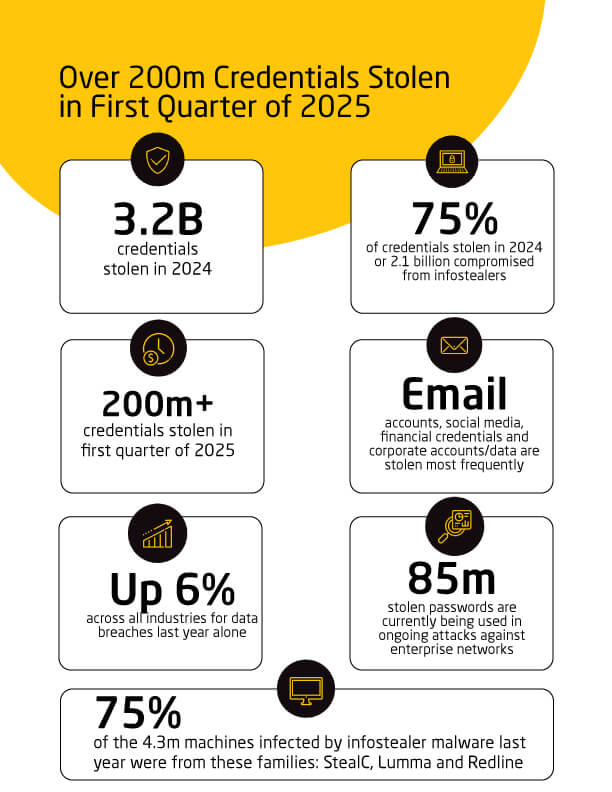Infostealers and Ransomware: Why Organisations Must Monitor the Dark Web as Ransomware Threats Rise

10 Jun 2025
Being Proactive Equips Companies with the Intelligence to Act Early, Reduce Risk, and Protect their Data
In an era where cyber threats are becoming more sophisticated, organisations are increasingly facing the risk of sensitive information being exposed on the dark web. The dark web has become a global marketplace for stolen data, credentials, and malware-as-a-service tools. As threat actors adopt more advanced techniques, especially the widespread use of infostealer malware (malicious software created to breach computer systems in order to steal sensitive information), organisations are under increasing pressure to detect and respond to data exposure before it escalates into significant operational or reputational damage.
Sensitive data and credentials are valuable currency on the dark web and attackers aren’t just targeting financial institutions or tech firms. As the recent cyber incidents impacting major UK retailers have shown, every sector is fair game. Understanding and utilising dark web scanning can play a pivotal role in preventing data breaches, mitigating risks, and safeguarding reputation and intellectual property.
What is the Dark Web?
The dark web is a section of the internet that exists outside of the reach of traditional search engines. Unlike the traditional web, which is publicly accessible and indexed by search engines, the dark web requires the use of anonymity-preserving tools, like the Tor Browser, that enable users to browse the dark web while keeping their location and usage private. The dark web is a hub for illegal activities, including the sale of stolen data, financial records, credentials, and lists of compromised systems. Threat actors use the dark web to trade this stolen information, often to enable broader attacks like ransomware or Business Email Compromise (BEC), making it a dangerous space for any organisation or individual whose data has been compromised.
The Growing Threat of Infostealers and Why it Matters
Infostealers have rapidly emerged as a critical threat vector. This malware is designed to silently extract credentials, browser cookies, saved passwords, network information, session tokens and other data from infected machines. The stolen data is bundled into searchable "logs" and sold on dark web markets, often for very little money.
This data, once in a threat actor’s hands, is often the first step in more sophisticated attacks. Ransomware operators and initial access brokers purchase or trade these logs to infiltrate networks, conduct reconnaissance, and launch encryption or extortion campaigns. The dark web tends not to be where the damage ends but in fact where many attacks begin.

Source: https://www.forbes.com/sites/daveywinder/2025/03/18/password-warning-as-21-billion-credentials-hit-by-infostealer-attacks/ and https://www.kelacyber.com/blog/understanding-the-infostealer-epidemic/
Why Should Organisations Prioritise Dark Web Scanning?
Dark web scanning is a process through which organisations can review the dark web for any signs that their data is being sold or shared in illicit forums. While it’s impossible to prevent every breach, dark web scanning helps businesses proactively identify compromised data – potentially before it can be used maliciously.
Here are some reasons why organisations should prioritise dark web scanning:
1. Early Detection of Data Breaches
Breaches can often go unnoticed for weeks or months. Scanning the dark web allows businesses to quickly identify if their data has been exposed or sold on the dark web. Early detection allows organisations to take immediate action to mitigate the damage and alert affected parties, such as customers or employees.
2. Combatting Infostealer and Ransomware Risk
Credentials harvested by infostealers can provide access to VPNs, cloud services, email accounts, applications and internal systems. Detecting those exposed credentials or systems and immediately disabling or containing them closes a critical gap in the ransomware kill chain.
3. Protecting Business Critical Data
Leaked intellectual property, client lists, internal emails, and financial documents can cause reputational and regulatory damage.
For organisations, customer trust and confidentiality are paramount. If sensitive business data ends up on the dark web, it can have a devastating effect on both the company’s operations and reputation. Timely detection through dark web monitoring helps to prevent data from being further exploited or weaponised by threat actors.
4. Reducing Risk and Exposure
Dark web exposure often indicates broader weaknesses like password reuse, lack of multi-factor authentication (MFA), or unpatched endpoints. By identifying compromised data early, businesses can prioritise remediation and limit risk before attackers exploit it further.
5. Enhancing Cybersecurity Measures
Dark web scanning isn't just about searching for data breaches; it’s a tool for improving an organisation’s overall cybersecurity posture. By identifying and responding to threats on the dark web, businesses can identify gaps in their security measures and enhance their internal processes. This could include improving employee training, adopting MFA, improving incident response or strengthening encryption protocols and internet footprint.
How Does Dark Web Scanning Work for Organisations?
Dark web scanning typically uses automated crawlers, threat intel feeds from dark web forums, paste sites, leak dumps, and marketplaces for organisation-specific data.
These search for sensitive information, such as:
- Employee and customer credentials
- Compromised email
- Stolen intellectual property, internal documents and financial data
- Compromised devices, including intelligence on internal systems and software
- Session cookies or MFA bypass data
Once a breach or sensitive information is detected, organisations are notified so they can take swift action to enable immediate triage and mitigation.
Benefits for Organisations
- Proactive Threat Detection: Identify compromised data before it’s used for ransom, identity theft, or network compromise.
- Mitigating Financial Impact: The more rapid response to early warnings reduces breach damage including recovery costs and business disruption.
- Strengthening Trust with Customers: Demonstrating cybersecurity commitment reassures customers, clients, and stakeholders.
Conclusion: Visibility Increases Protection
Dark web scanning should no longer be considered a nice-to-have. It has become an essential cyber defence strategy for organisations. From infostealers to ransomware gangs, today’s threats don’t wait. By adopting dark web scanning, organisations can identify early signs of exposed data, respond to potential threats, harden their access controls and bolster their overall security posture.
Recent cyberattacks across a broad range of industry sectors are a reminder: no business is immune, and no credential is too small to be exploited. Visibility into the dark web gives organisations the intelligence they need to act early, reduce risk, and protect their data.



